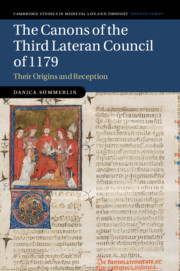Book contents
- The Canons of the Third Lateran Council of 1179
- Cambridge Studies in Medieval Life and Thought Fourth Series
- The Canons of the Third Lateran Council of 1179
- Copyright page
- Dedication
- Contents
- Tables
- Acknowledgements
- Abbreviations
- Walther-Holtzmann Kartei
- Note on Citation Styles
- Introduction
- 1 Historical Survey
- 2 Disputes, Decretals, and the 1179 Conciliar Canons
- 3 The 1179 Canons and the Schools
- 4 The Dissemination of the 1179 Canons
- 5 Use of the Canons, ca. 1179–ca. 1191
- Conclusions
- Appendix: Manuscript Listing of the 1179 Canons
- Bibliography
- Manuscript Index
- General Index
5 - Use of the Canons, ca. 1179–ca. 1191
Published online by Cambridge University Press: 08 November 2019
- The Canons of the Third Lateran Council of 1179
- Cambridge Studies in Medieval Life and Thought Fourth Series
- The Canons of the Third Lateran Council of 1179
- Copyright page
- Dedication
- Contents
- Tables
- Acknowledgements
- Abbreviations
- Walther-Holtzmann Kartei
- Note on Citation Styles
- Introduction
- 1 Historical Survey
- 2 Disputes, Decretals, and the 1179 Conciliar Canons
- 3 The 1179 Canons and the Schools
- 4 The Dissemination of the 1179 Canons
- 5 Use of the Canons, ca. 1179–ca. 1191
- Conclusions
- Appendix: Manuscript Listing of the 1179 Canons
- Bibliography
- Manuscript Index
- General Index
Summary
The final chapter completes the analysis, weaving together themes from previous chapters to investigate how the canons were used. Beginning with the papal deployment of the conciliar authorities, the chapter suggests an inherent flexibility: while the papacy would reaffirm the conciliar decrees in some circumstances, in others it would use them merely as guidelines. The chapter then turns to local and episcopal use of the conciliar decrees, showing that in some cases bishops followed the stipulations, while elsewhere they attempted to avoid, change, or interpret them. Finally, the use of the decrees by canon lawyers, both in the schools and in episcopal retinues, is considered: immediately after the council, there was no one way in which these lawyers treated and understood the decrees, and it was only with Bernard of Pavia’s canonical collection known as the Breviarium Extravagantium (ca. 1191) that canon lawyers began to interpret them as overarching, general stipulations. Overall, the chapter points to the plurality of ways in which twelfth–century clerics conceived of papal and conciliar power and authority, with both conciliar decrees and papal decretals being viewed with uncertainty as they became established legal precedents.
Keywords
- Type
- Chapter
- Information
- The Canons of the Third Lateran Council of 1179Their Origins and Reception, pp. 183 - 240Publisher: Cambridge University PressPrint publication year: 2019

